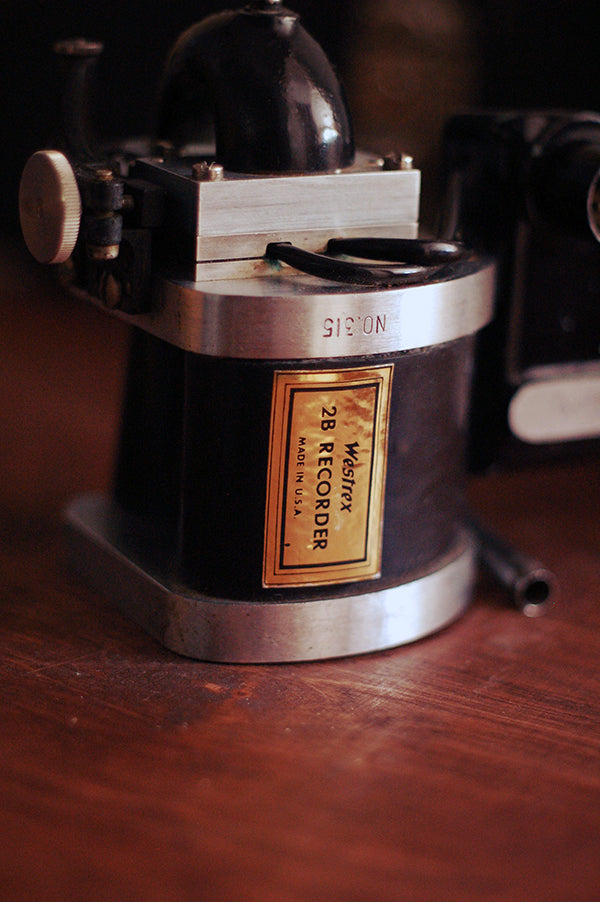Some time ago we were asked to repair a vintage Westrex 2B feedback cutter head at Agnew Analog Reference Instruments.
As with all Western Electric and Westrex products, their disk recording cutter heads, commonly used with Scully lathes, were beautifully made and represented the state of the art in their time. Not only did they sound great, they also looked aesthetically pleasing, with curved lines that were not a trivial task to manufacture in the days before CNC machine tools, CAD software and pocket calculators!


The Westrex 2A cutter head.
The Westrex 2A was introduced in 1948 and was followed by the 2B in 1954. It was a monophonic moving-coil cutter head, with a feedback coil that would generate a signal that was proportional to velocity. This signal would be fed back to the cutting amplifier system to correct errors, as a closed-loop control system. This type of feedback was known as motional feedback. The concept had first been patented by Leonard Vieth, Charles Wiebusch and George Yenzer, working for Bell Telephone Laboratories (who else?), with the patent application filed in 1937. Hardly surprising, as Bell Telephone Laboratories and their subsidiaries have invented pretty much everything that our modern civilization and lifestyle was built up on, from the telephone, motion picture and sound recording equipment, all the way to the Unix operating system, the C programming language and countless other things in between. You wouldn't be reading this if it wasn't for Bell Labs, because there would be no internet.
The Westrex 2B is one of the very best-sounding cutter heads of the monophonic era and still in use today in several facilities around the world, many if not most retrofitted with Agnew Analog parts.

Another view of this magnificent vintage cutter head.
This particular example had suffered damage to its stylus mount. In addition, the original taper shank stylus, which would fit into a tapered socket in the head in very much the same manner as taper tooling in machine tools, is no longer available. While we do make adapters that permit the use of the currently-available Neumann type stylus (models NSH-2, 320, etc.) with the Westrex 2B cutter head, the damaged stylus socket did not permit their use.
Instead, I decided to take apart the head and machine the stylus mount so that we could permanently fit a socket for the Micro-Point NSH-2 disk recording stylus type.

A fine example of old-school craftsmanship.
But first, the remains of a stylus that had broken inside the microscopically-small taper hole had to be extracted so that the part could be machined as needed.
The operation was concluded successfully and also required the machining of an insanely small part for the advance ball assembly, which is used to set the depth of cut when this head is used with a Scully lathe or a similar application.

The Westrex 2A had to be re-machined with extreme precision.

Ready for more long-term service.
The preservation of our cultural heritage and the continued use of such technology is essential for future generations to be able to comprehend how we got to where we are now, not only in terms of technology but also as a society. There are important lessons to be learned along the way, not least when considering how few of these cutter heads were ever made and that most of them are still in regular commercial service, 68 years later! Quality over quantity.
Nowadays, many find it preferable to produce large numbers of goods that are barely functional when they leave the factory, let alone several decades later.
There is perhaps a correlation there, with the economic prosperity that followed the introduction of such high-quality products, and the economic and social decline we are witnessing at present. People who can be truly proud of their creations tend to be happier and more successful in passing something down to their children. We feel truly inspired when witnessing the level of craftsmanship that went into these products, and we see it as our duty to preserve the knowledge, the techniques, the equipment and the mentality, for those who can appreciate it.
It will take a good look at the history books to stand a chance of seeing bright days ahead of us once again.
Editor’s note: the Western Electric name is alive and well, thanks to the efforts of Charles Whitener, who reestablished the business in 1996 at the company’s Rossville, Georgia location. They currently offer a reproduction of the original Western Electric 300B tube and a range of audio components, speaker drivers and accessories. Western Electric has announced plans to manufacture the 12AX7 tube, and are looking at offering other popular tube types for audio gear and guitar amps.
All images courtesy of Agnew Analog Reference Instruments.
Note: This article was first published as a blog post on the Agnew Reference Analog Instruments website. It appears here in edited form by permission of the author.


